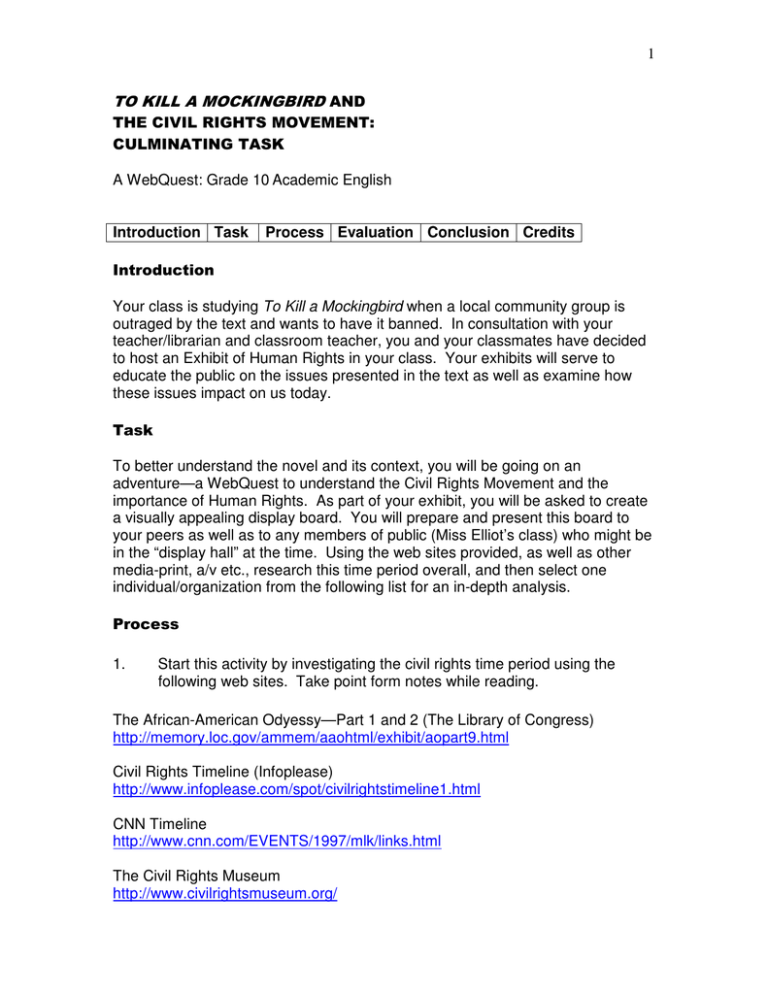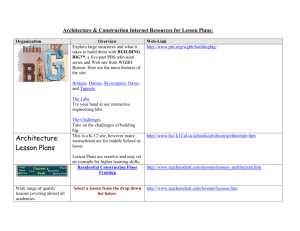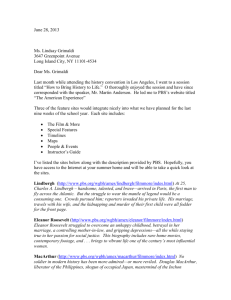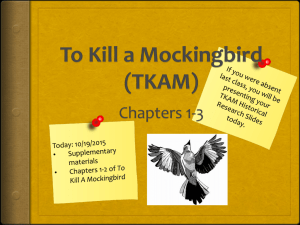TO KILL A MOCKINGBIRD
advertisement

1 TO KILL A MOCKINGBIRD AND THE CIVIL RIGHTS MOVEMENT: CULMINATING TASK A WebQuest: Grade 10 Academic English Introduction Task Process Evaluation Conclusion Credits Introduction Your class is studying To Kill a Mockingbird when a local community group is outraged by the text and wants to have it banned. In consultation with your teacher/librarian and classroom teacher, you and your classmates have decided to host an Exhibit of Human Rights in your class. Your exhibits will serve to educate the public on the issues presented in the text as well as examine how these issues impact on us today. Task To better understand the novel and its context, you will be going on an adventure—a WebQuest to understand the Civil Rights Movement and the importance of Human Rights. As part of your exhibit, you will be asked to create a visually appealing display board. You will prepare and present this board to your peers as well as to any members of public (Miss Elliot’s class) who might be in the “display hall” at the time. Using the web sites provided, as well as other media-print, a/v etc., research this time period overall, and then select one individual/organization from the following list for an in-depth analysis. Process 1. Start this activity by investigating the civil rights time period using the following web sites. Take point form notes while reading. The African-American Odyessy—Part 1 and 2 (The Library of Congress) http://memory.loc.gov/ammem/aaohtml/exhibit/aopart9.html Civil Rights Timeline (Infoplease) http://www.infoplease.com/spot/civilrightstimeline1.html CNN Timeline http://www.cnn.com/EVENTS/1997/mlk/links.html The Civil Rights Museum http://www.civilrightsmuseum.org/ 2 2. Select one person/organization from the following list and research this particular individual or group using the web sites below. Along with the basic biographic information about the person/organization, examine the following details: • • • • • What human rights issue(s) are associated with this person/group? What prompted this issue to emerge in its respective time period and place? At the time, how did people react to this person/group? Has this perception changed in 2007? Was this group/individual successful in achieving their human rights goals? At what cost? Agree or disagree with the approach this person/group used to achieve their goals. What impact did this person/group’s actions have on the civil rights movement overall? Use several different sources along with the numerous text resources in our library. Record information as you research on the organizer provided. TOPICS: Martin Luther King Jr. Malcolm X Black Panthers Japanese Internment Apartheid in South Africa Rosa Parks or any of the civil rights individuals mentioned on the Civil Rights Timeline. PBS (has several sites on specific individuals or events on civil rights) http://www.pbs.org/wgbh/amex/scottsboro/ http://www.pbs.org/wgbh/amex/mlk/ http://www.pbs.org/wgbh/amex/till/ http://www.pbs.org/wnet/jimcrow/ The Black Panthers http://www.blackpanther.org/ The Rise of Black Power http://www.colorado.edu/AmStudies/lewis/2010/power.htm Canadian Museum of Civilization Corp. http://www.civilisations.ca/ Canadian Civil Rights http://www.planetfriendly.net/rights.html 3 Japanese Canadian History http://www.japanesecanadianhistory.net/home_page.htm The History of Apartheid in South Africa http://www-cs-students.stanford.edu/~cale/cs201/apartheid.hist.html http://www.anc.org.za/un/ http://www.anc.org.za/people/mandela.html http://www.mcps.k12.md.us/schools/woottonhs/English/crybeloved/apartheid.htm 4. Once you have finished all the research on your specific topic, determine the focus and presentation details of the display board. 5. Examine the following web pages to get a sense of the status of civil/human rights today. *** 6. Draw some conclusions on the following points to include in your report. a) b) c) How much of an impact did the Civil Rights Movements have in shaping our world today? What key issues did the novel, To Kill A Mockingbird, reveal to you? Should we still continue to study this novel, and why? Today, are we better or worse in dealing with issues related civil/human rights? Amnesty International Human Rights Watch United Nations Human Rights Internet *** www.amnesty.ca or www.amnesty.org http://www.hrw.org/ www.un.org http://www.hri.ca/index.aspx 7. Prepare a short report summarizing the key points of your research. Make sure that you have answered the questions in steps #2 and #6. Document all your research in a Works Cited. Refer to the MLA Style Guide. 8. Create a visual—poster board with photos, illustrations and text that explains the key human rights issue of your topic and how it relates to the novel. 9. Present the display board to peers/public—be ready to discuss any questions raised by your topic/presentation. 4 Evaluation Your final report will be assessed on accuracy and choice of content as well as the design of your display board. Rubric to follow. Conclusion After this activity, you will have gained insight into the people and events of the civil rights era, a sense of where civil rights issues stand today and the effect this movement had on shaping the novel To Kill a Mockingbird. Credits Designed by Lily Milanovich: Thanks to Brenda Dillon, T/L Philip Pocock, for her help and guidance with this project. As well as the English Teachers at St. Marcellinus and Philip Pocock for their suggestions on creating this activity and the sources noted. St. Marcellinus Student Agenda, Mississauga: Premier Agendas, 2004. Student Research Guide—Library and Learning Resources. Toronto: Toronto District School Board, 2003. Display Board Instructions & Evaluation DISPLAY BOARD: Introducing The Civil Rights Movement Create a display board for your assigned topic which contains meaningful, relevant background information and engages the audience (the class) visually. Points to Explore: • • • • • • Definitions (i.e. key terms) Facts and highlights (e.g. key events; important people) Categories of information Timelines Examples Explanations Techniques for Presentation: • • • • • • Headings and subheadings Font/print size and colour Layout (arrangement and spacing) Images and illustrations Charts and diagrams Poster design (i.e. line, shape, balance, contrast)



